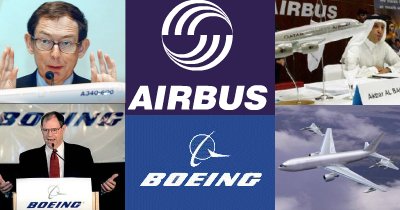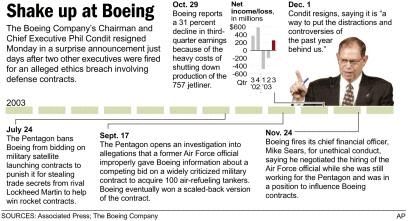December 08, 2003
Boeing vs. Airbus: Airbus Comes Out On Top

The aerospace industry has suddenly gotten really interesting. The week after Boeing's CEO Phil Condit quit the company amid the latest round of ethical misdeeds, Airbus vice president for market forecasts, Adam Brown, told reporters at the Dubai Air Show that his company had 55 percent of the market against 45 percent for Boeing, taking orders for 263 aircraft since the beginning of the year - 47 more than Boeing, crowning Airbus "the world's leading supplier" of commercial jets. Airbus, based in the French city of Toulouse, says it has sold 4,854 aircraft to 186 companies since its inception in 1970.
But Chicago-based Boeing remains unshaken. "There is no question this year they will be delivering a few more aircraft than us, but we are not concerned about one downturn year," Boeing's marketing vice president, Randy Baseler, told The Associated Press:
-
Promoting the A380, marketed as the world's largest passenger aircraft, Airbus said Monday its new carrier is the future of airline growth. The 555-seat plane, designed to fly nonstop for long hours, is scheduled for its first flight in 2005, with deliveries set to begin in early 2006. There have been 129 orders for the craft from 11 countries, including Dubai-based Emirates airline and Doha-based Qatar Airways. "Based on our experience we see nothing on the horizon which can cost-effectively supersede the aircraft we offer today," Brown said.
In its separate news conference, Boeing expressed skepticism about Airbus' market forecasts, saying airlines usually handle growth in air travel by increasing frequencies and nonstop flights, not plane sizes. Boeing also says the A380's size would require airport adjustments and changes in the way airlines do business. Baseler said the future is for smaller jets. "On the global scale, we see market fragmentation — or 'point-to-point' operations_ continuing, which means airlines will rely more and more on smaller airplanes," he said. Baseler said this is why Boeing believes the future of its 250-seat 7E7 Dreamliner, which is planned for 2008, is promising. Brown said Boeing seems to be "in a parallel universe," adding that the A380 has had "the biggest market response to any jet" in numbers of orders.
Meanwhile, I found another biting commentary on Slate.com about the Boeing's recent slide, "Jet Lag: How Boeing Blew It"... here's an excerpt:
-
...as Boeing managers tried to fit McDonnell Douglas into the corporate mix, Airbus took off. One story has it that an Airbus executive boasted in 1997 that his company's sales would easily surpass Boeing's by 2003. Phil Condit, attending the same meeting, laughed. Now Airbus holds a huge lead over Boeing in orders; in 2002 and 2003, Airbus commanded nearly 60 percent of the global market—precisely the dominant share that Boeing enjoyed back when Condit was so amused.

Boeing's plummet matters in a big way, and not just for Boeing. The company has long been a major exporter: A single order of 747s (most of which sell for around $200 million) is capable of putting a sizable dent in the U.S. trade deficit, which likely will surpass $500 billion for 2003. Those fat orders now are essentially gone. Sales of 747s have screeched to a halt since Airbus announced plans to build the 550-passenger A380, due to fly in early 2005.
The sight of a European or Asian airport packed with 747s and 777s says one thing about the United States. Those same airports crammed with Airbus A340s—and, before long, with mammoth A380 superjumbo jets—say another. Boeing's diminished clout in commercial aviation is also bad news for the U.S. airline industry, which may soon find itself with only one viable source of aircraft: Airbus. Goodbye to all the sweet deals the airlines extracted from Boeing or Airbus when the two were fiercely competing.
To save itself, Boeing needs to accomplish two feats. One is to mend fences with the Pentagon and save the deal under which it will build 100 767 jets to serve as midair tankers (the only hope for the aircraft, which no commercial customer now wants). That may not be terribly hard; the Air Force really, truly wants those tankers, and even John McCain's blustering over the deal isn't likely to impede it.
But the other more important challenge for Boeing is to get back to basics in commercial aviation, which after all is what built the company during the 1960s and 1970s. Whether Boeing is up to the task is far from clear. After fiddling in recent years with notions for a supersized 747 and a fast jet called the "sonic cruiser," Boeing has decided its savior will be a jet called the 7E7 "Dreamliner." This twin-engine, 220-seat jet is supposed to give airlines a comfortable, superefficient plane that dovetails nicely with the move away from hub-and-spoke airline flight patterns and toward the point-to-point flights preferred by customers.
Ironically, says Paul Czysz, a professor emeritus of aeronautics at St. Louis University, that might have been found in the McDonnell Douglas archives. During the 1980s and 1990s, engineers there developed what is called the "blended wing"—a variation on the flying-wing model used in the B-2 bomber. Basically, a blended wing is simply a fat wing with the engines and tail fins attached to it—no long skinny tube with the wings stuck on the side. It's an ideal design for commercial aircraft—even more fuel efficient than the proposed 7E7, capable of carrying huge loads, easily switched between passengers and cargo and back. Should any U.S. aviation company actually build a commercial version, says Czysz (full disclosure: He's a former McDonnell Douglas guy), no other airliner could compete. Boeing toyed with something a little like the blended wing with its proposed sonic cruiser, but scrapped that in the wake of Sept. 11 and the collapse of commercial aviation.
The 7E7, offered in its place, is certainly a safer bet. But if the Dreamliner isn't a winner—and there is no clear evidence that it will offer airlines something that Airbus can't—the odds are good that Boeing will be out of the commercial aircraft business in 10 years. To leapfrog Airbus, Boeing needed to roll the dice. Instead, its new culture of soaking the taxpayers for military goodies while playing it safe on the commercial-aircraft front may have cost Boeing its future and blown a hole in the U.S. economy that never will close.
Undoubtedly, without the competition between Boeing and Airbus over the past 30 years, the flying public as well as our militaries would be worse off, so I sincerely hope Boeing can start getting its act together... for the good of its shareholders, the U.S. economy and that of global aviation.
- Arik
UPDATE: On Wednesday 10 December, AP reported from Paris that Airbus said it has been gathering information on public aid to Boeing to check whether Washington has breached an agreement with Brussels, and is particularly concerned about pledges of U.S. government support for its U.S. rival's planned new fuel-efficient passenger jet, the 7E7 "Dreamliner."
-
"We're following very closely what's happening with the 7E7 and forwarding the information we are gathering to the EU authorities," Airbus spokesman David Voskuhl said. He was speaking after French daily Le Figaro on Wednesday quoted Airbus CEO Noel Forgeard voicing concern over Boeing funding. "We want European Union countries to know what's going on," Forgeard was quoted as saying.
Under the terms of a 1992 bilateral accord on civil aviation, the United States and the European Union pledged that government loans would not be allowed to exceed 33 percent of total investment by their respective aerospace companies. Since then, however, both sides have repeatedly accused each other of breaking the deal.
Airbus is concerned about government loans and subsidies promised to the Japanese companies lined up for about one third of the manufacturing work for the 7E7. These include Japanese engineering firms Mitsubishi, Kawasaki and Fuji.
Boeing spokesman Todd Blecher said he found it "ironic" that Airbus was raising concerns about potential support for the 7E7, given "the billions of dollars in subsidies Airbus has received for more than 30 years."
"It's premature for anyone anywhere to speculate on the specific funding mechanism our partners might use for the 7E7," Blecher said.
ANOTHER UPDATE: On Tuesday 16 December, Boeing announced it would begin booking orders for the new 7E7 Dreamliner.
-
"This is a capital-intensive business and this aircraft is a gamble, but it's a smart gamble," said John Murray, an analyst who covers Boeing for Delaware Investments, which owns Boeing shares. "If they didn't do it, Airbus would be standing alone in this business in 40 years."
Without the 7E7, analysts say Boeing would be relegated to also-ran status in the two-horse race with Airbus, which has become the world's most prolific jetliner maker with a backlog of 1,467 jet orders compared with Boeing's 1,112.
Airbus officials have called the 7E7's improvements over Boeing's current jets minor, saying price discounts on the competing A330-200 could eliminate any advantage the 7E7 might bring for airlines.
"When Airbus says they are going to offer discounts, they are already admitting theirs is an inferior product," said Randy Baseler, vice president for marketing at Boeing's commercial jet unit.
Airbus Chief Commercial Officer John Leahy said the A330-200 would beat the 7E7 and win at least half the 1,800 jet orders he expects for mid-sized jets over the next 20 years, expressing surprise that Boeing would spend so much money just to match the A330.
"If the question is: If they bring out the 7E7 what are we going to do, the answer is nothing. We are very content to stay with our A330-200," Leahy told Reuters.
The 7E7 would replace the slow-selling 757, which Boeing is discontinuing, and the 767 line, which has slowed to just one aircraft per month to sustain production until a controversial order for 100 U.S. Air Force fuel tankers is finalized.
The company had considered about 20 locations for a 7E7 assembly plant, eliciting a wide range of offers to cut taxes and build new roads and facilities, including a $3.2 billion aerospace industry package from the state of Washington.
The 7E7 will create just 800 to 1,200 Boeing jobs in Washington, but thousands more will go to local suppliers and state officials were determined to keep the jet business at home after Boeing moved its headquarters to Chicago in 2001.
"It would be more devastating to our economy and our government coffers if Boeing did not build the 7E7 in our state," Washington Gov. Gary Locke told Reuters by telephone. "We would have seen the gradual relocation of Boeing commercial activities to another state, and the loss of 130,000 direct and indirect jobs."
 "Competitive Intelligence applies the lessons of competition and principles of intelligence to the need for every business to gain awareness and predictability of market risk and opportunity. By doing so, CI has the power to transform an enterprise from also-ran into a real winner, with agility enough to create and maintain sustainable competitive advantage."
"Competitive Intelligence applies the lessons of competition and principles of intelligence to the need for every business to gain awareness and predictability of market risk and opportunity. By doing so, CI has the power to transform an enterprise from also-ran into a real winner, with agility enough to create and maintain sustainable competitive advantage."
